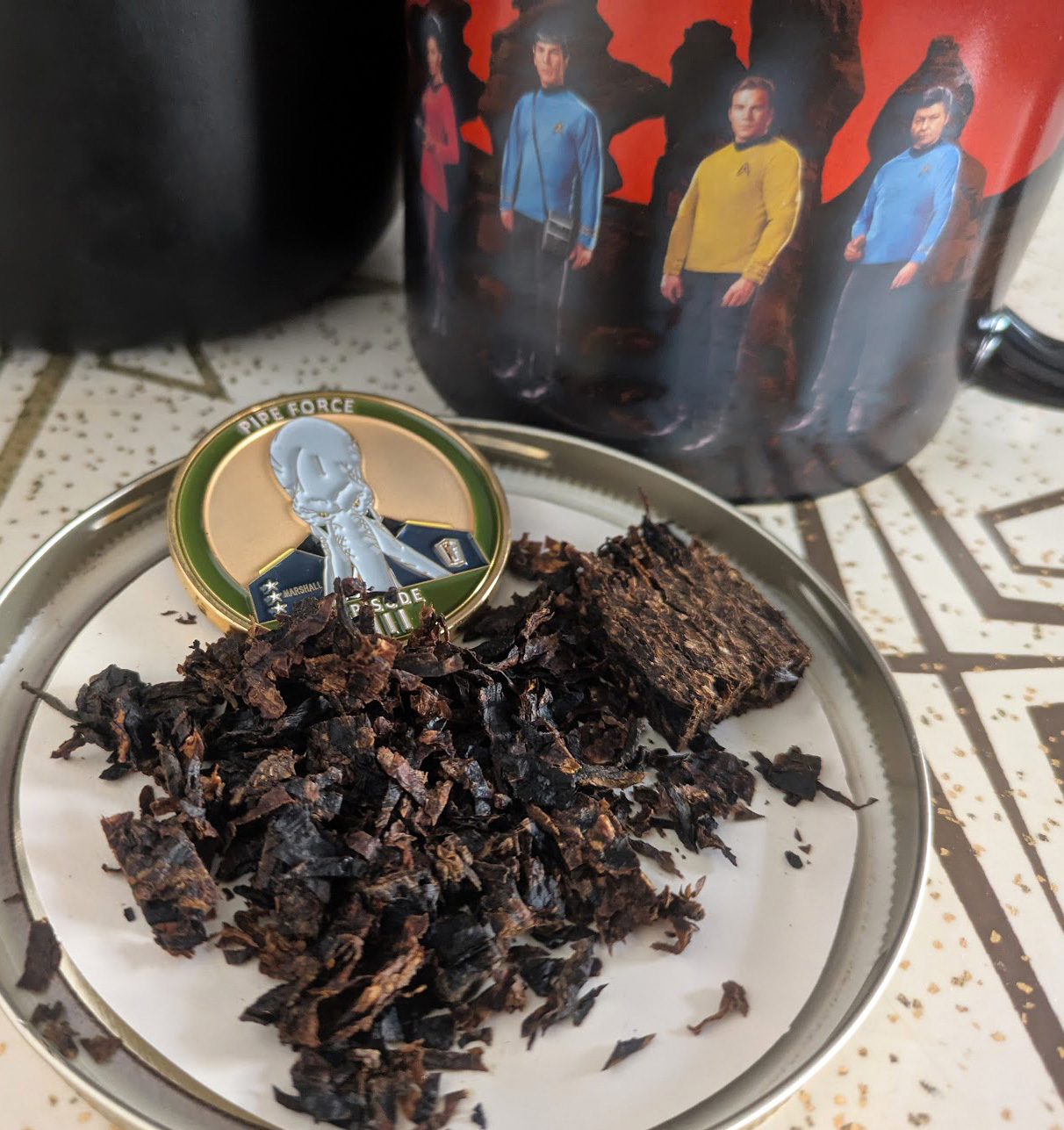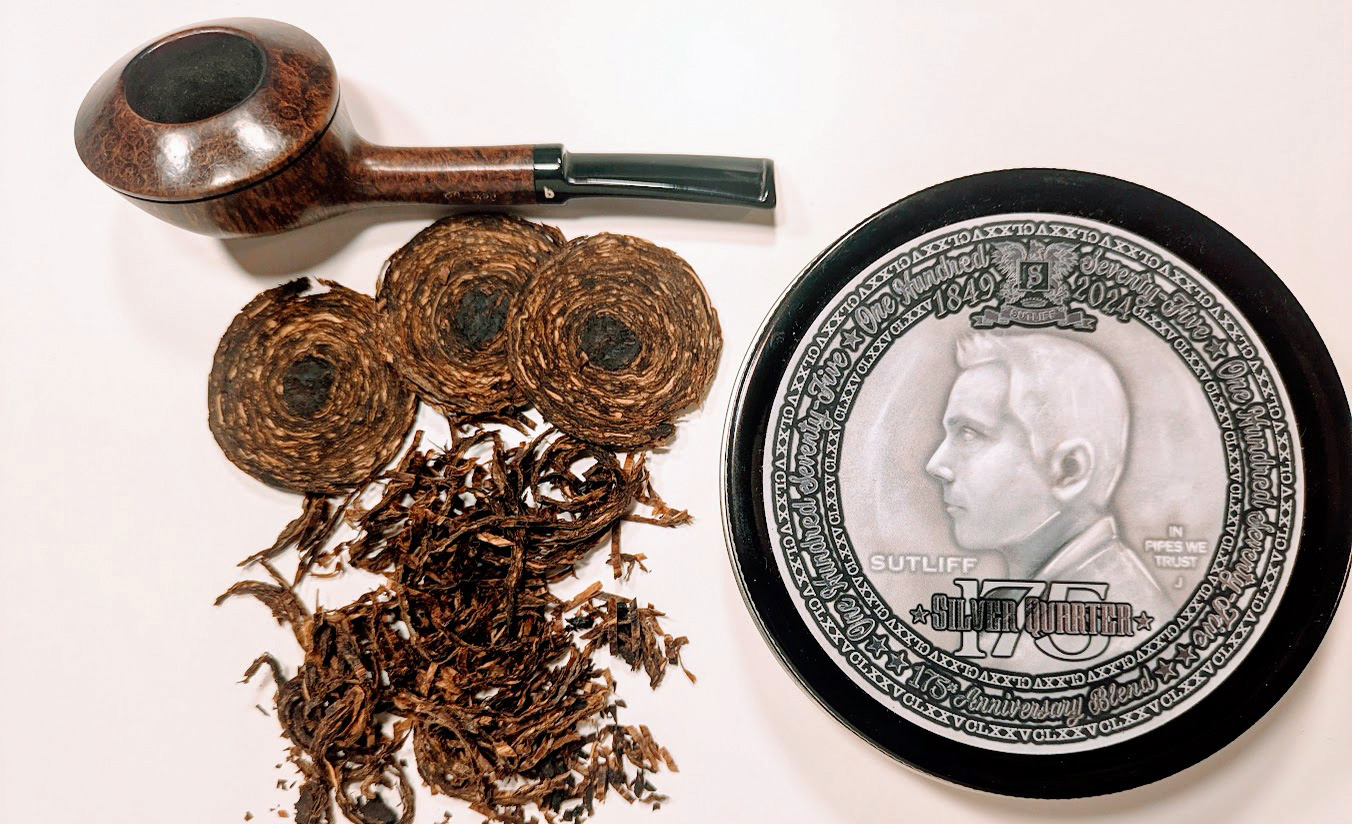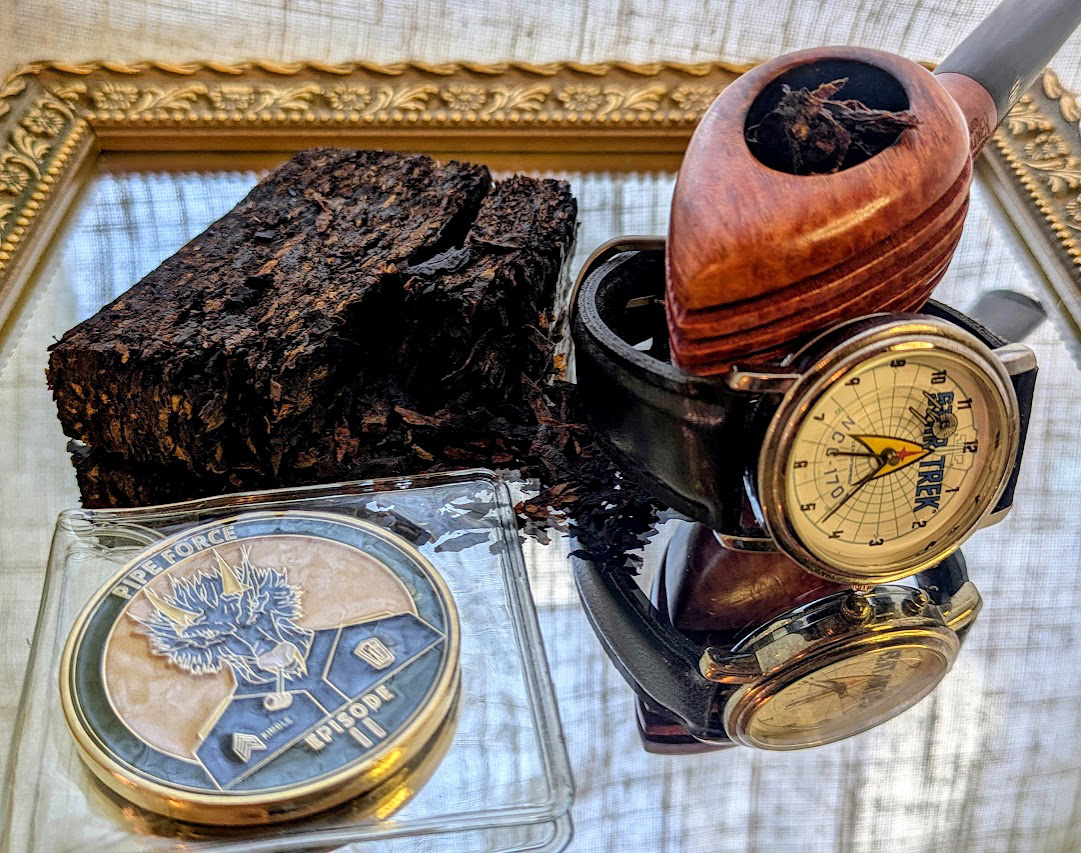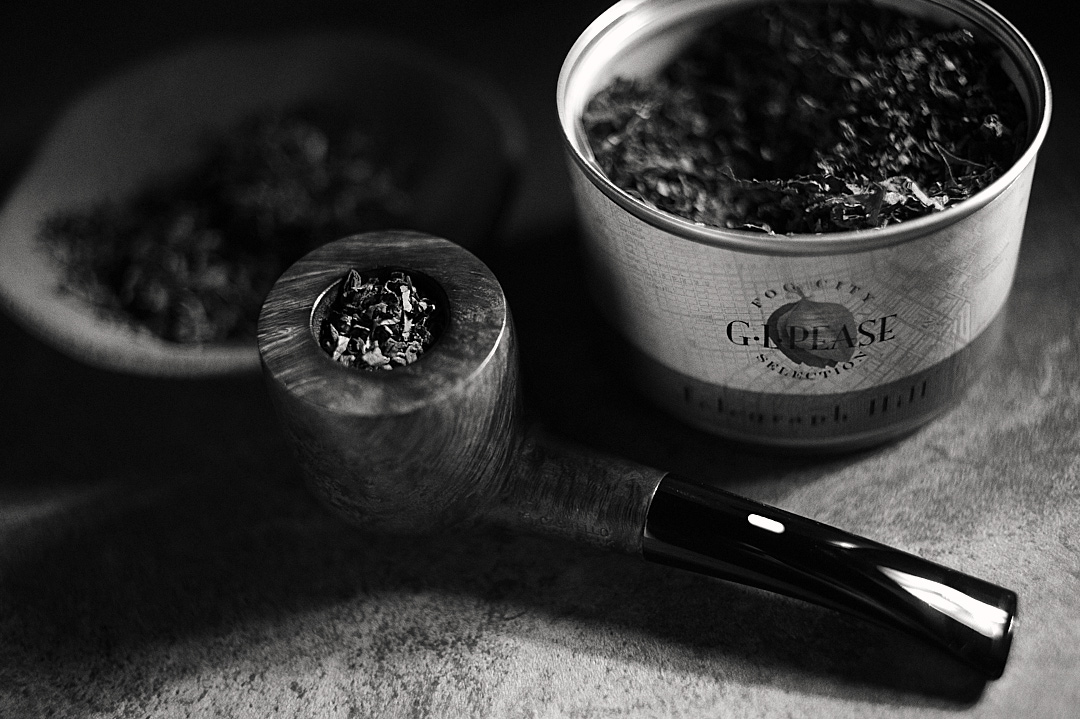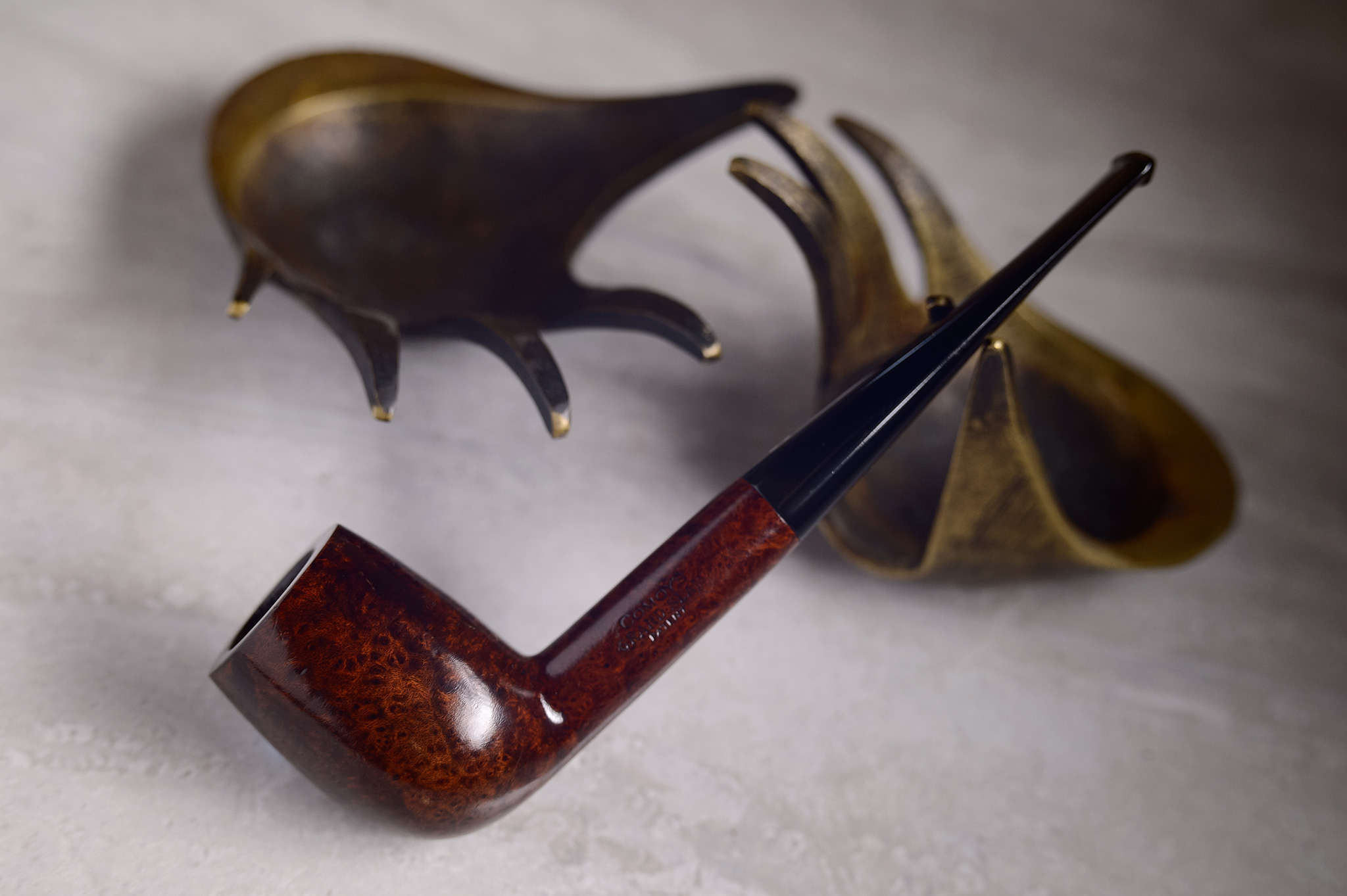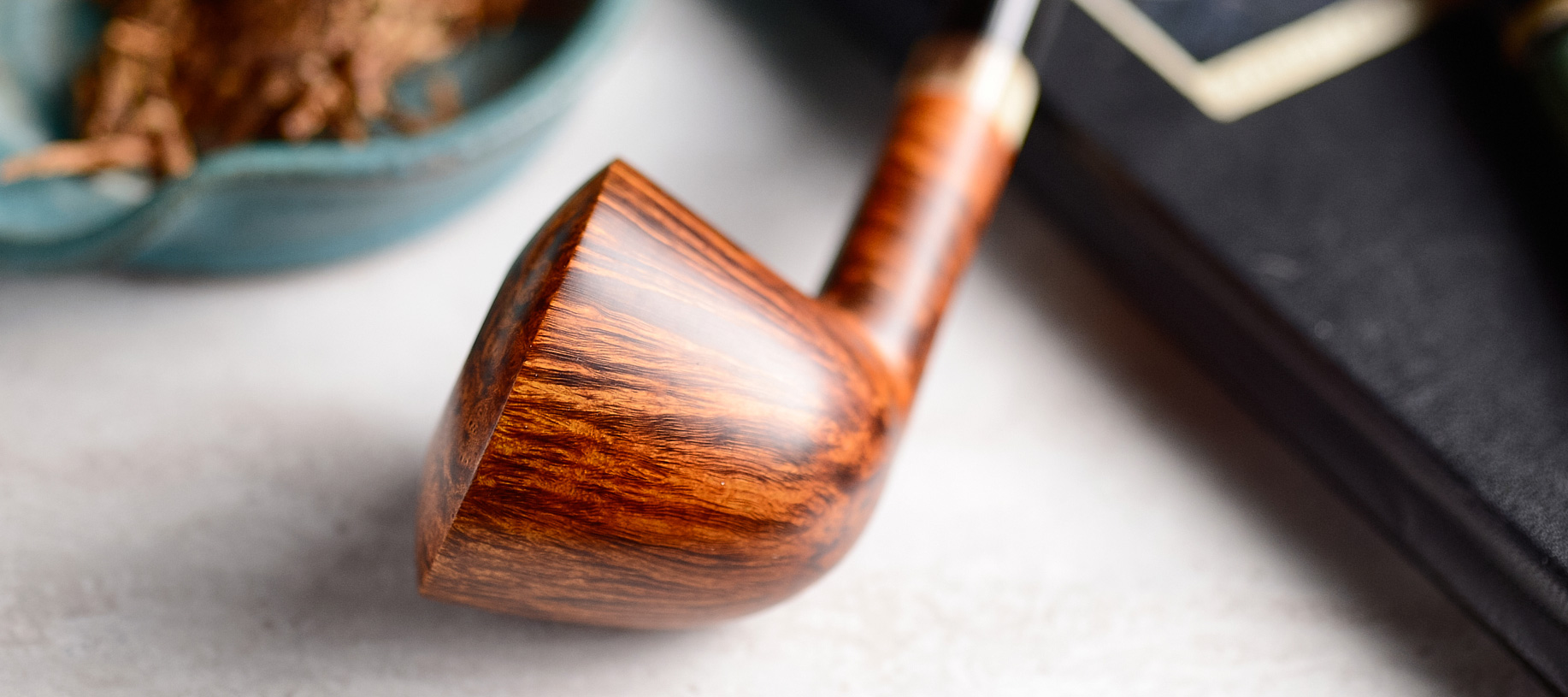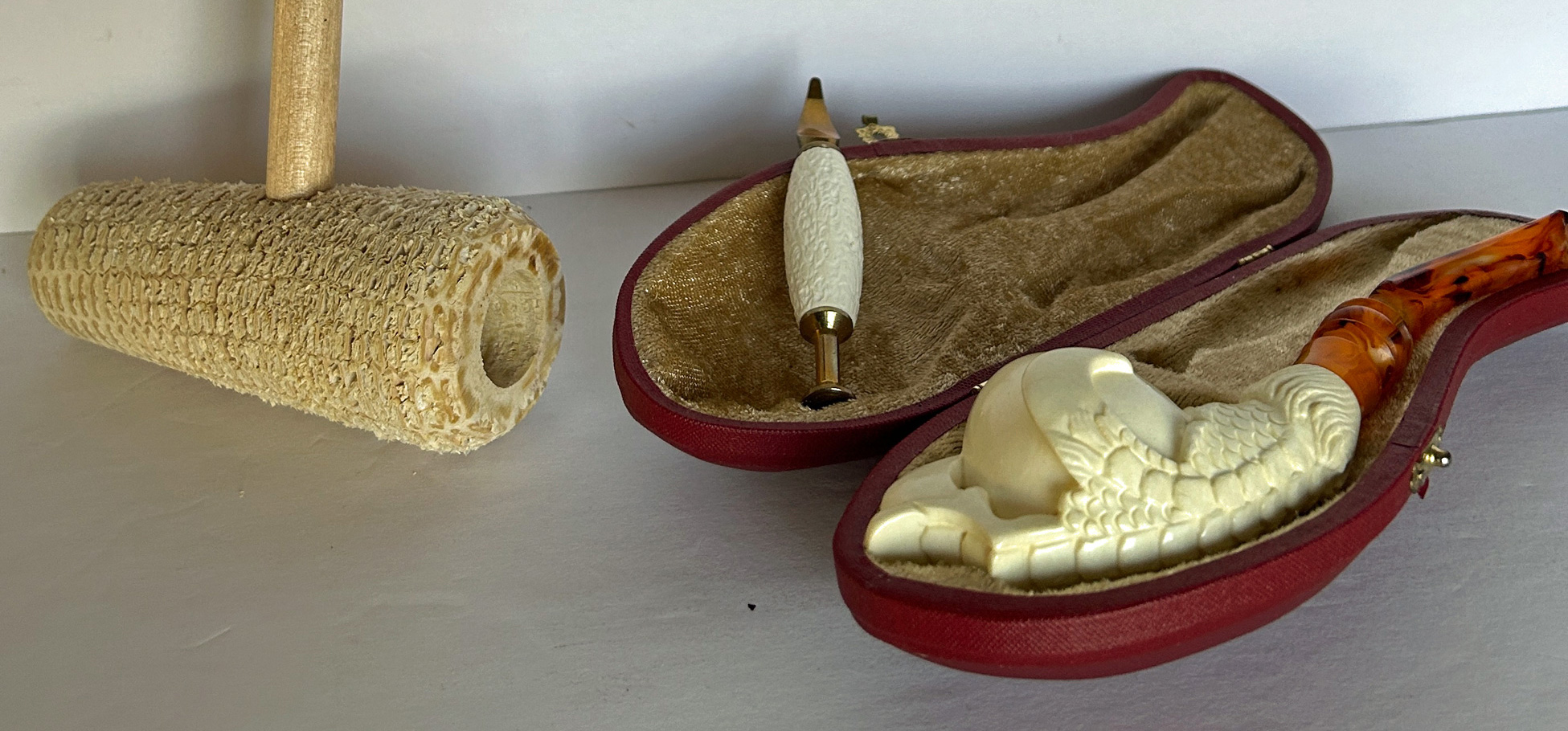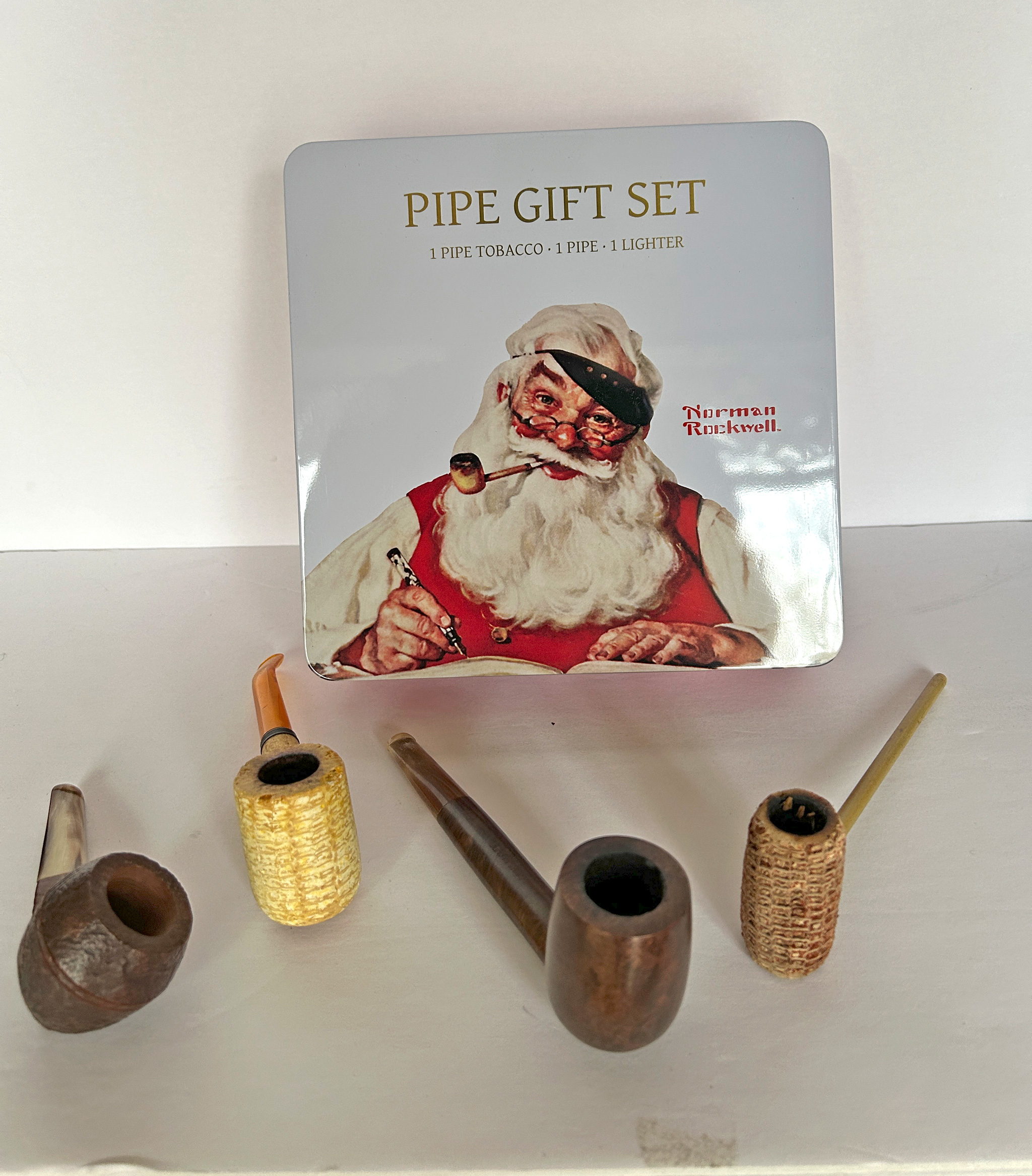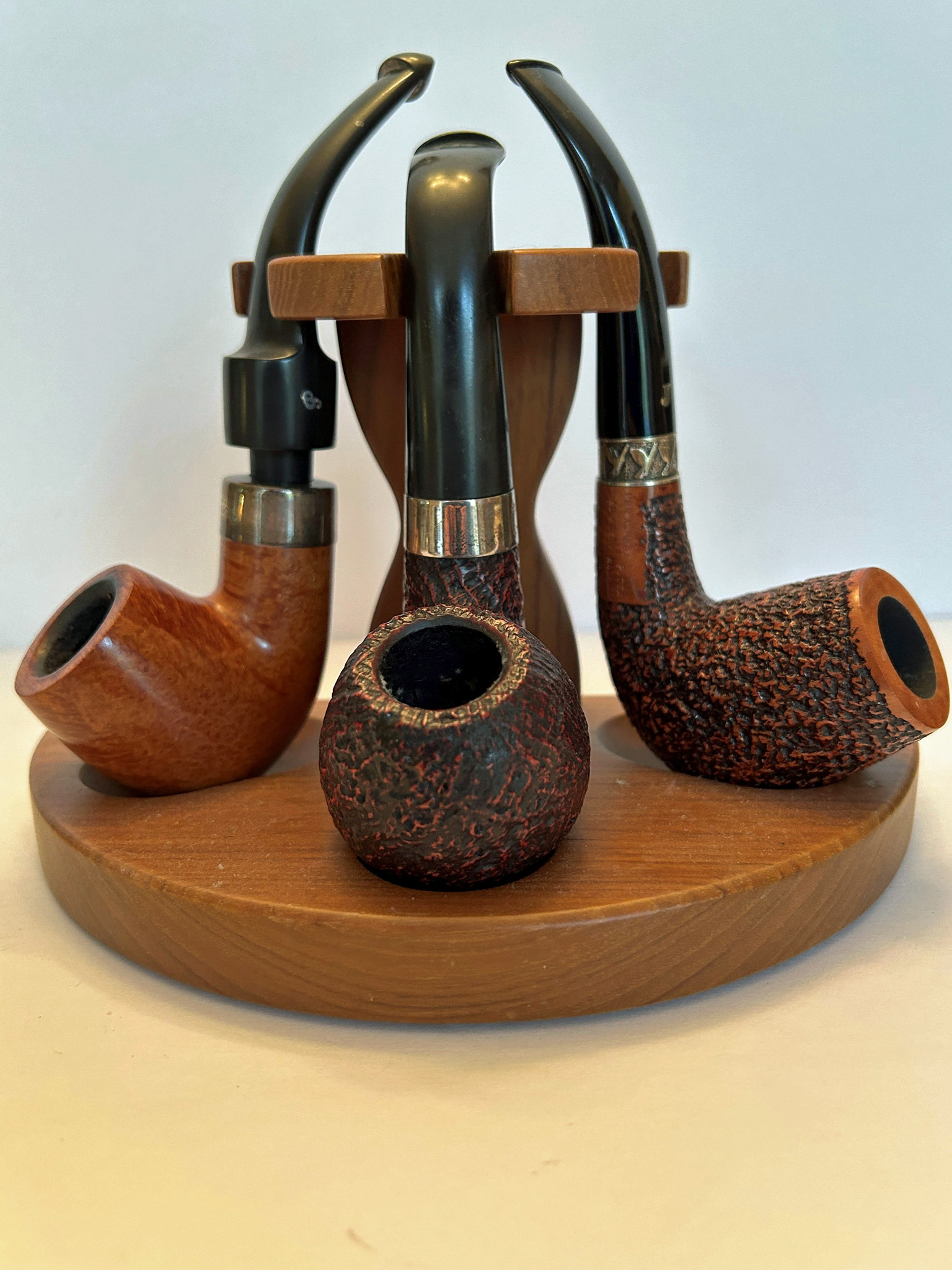Smokingpipes.com Updates
Radio Talk Show
- Pipes Magazine Radio Show Episode 644
Welcome to The Pipes Magazine Radio Show Episode 644. Our featured interview tonight is with Jay Furman. Jay is the co-host of the Pipe and Tamper podcast. He is a long-time member of the pipe community. He started smoking pipes in the 1980s, and owns hundreds of pipes and hundreds of pounds of pipe tobacco. His first pipe shopping experience was at Wally Frank, a famous New York chain of shops, also nationally known for their large mail order catalog business. Jay loves artisan pipes as well as health and fitness. Brian and Jay will have an extended conversation that will preempt the Pipe Parts segment. We will still have music, mailbag, and rant.
- Pipes Magazine Radio Show Episode 643
Welcome to The Pipes Magazine Radio Show Episode 643. Our featured guest tonight is Dr. Fred Hanna. Fred is a well-known pipe collector, author, and speaker at pipe shows. He has a PhD. in psychology and teaches the same at the Chicago Campus at Adler University. He has also done extensive research on nicotine, and that will be the focus of the discussion tonight. Nicotine has often been cast as a villain, but it is not really harmful. It naturally occurs in the nightshade family of plants, which includes tomatoes, potatoes, and eggplants. At the top of the show, Brian will talk more about the Sutliff/McBaren/STG situation that has the serious pipe smoker segment of the market furious.
- Pipes Magazine Radio Show Episode 642
Welcome to The Pipes Magazine Radio Show Episode 642. Our featured guest tonight is Jon David Cole. JD is the Owner/Tobacconist at The Country Squire in Jackson, MS, and the accompanying online store. We’ll have JD and Brian talking about Jon David’s personal pipe collection, sales trends for pipes and tobacco at the shop, and the challenges presented by the pending closure of Sutliff Tobacco. They have been the supplier of many component tobaccos for several of The Country Squire’s house blends. If you haven’t heard the news from earlier this year – Scandinavian Tobacco Group bought Mac Baren, which owned Sutliff. Internal documents were leaked from STG showing that they will be shutting down Sutliff completely, and eliminating most of the products. This will be an extended conversation, so we will skip the usual Pipe Parts opening segment.
Tobacco Reviews
- Pipe Force Episode III & Cringle Flake Holiday Edition 2024 Reviews
There is a transitory nature to this enjoyment of pipes and tobacco, making it an easy metaphor for the nature of time and our place within its flow, and, hopefully, enhancing our appreciation to lend focus to moments which we allow our perceptions to linger within. It is ephemeral, like all things we hold dear; so, too, the holiday season aims to serve as reminder to enjoy and cling to those moments—with family, loved ones, and spirit of good cheer. As another holiday season winds down and confronts us with the promise of renewal in the year ahead, let’s keep that in mind as we examine some of the sunset offerings from the Sutliff Tobacco Company. Pipe Force Episode III Stoved and Red Virginia give a naturally sweet, tangy, woody foundation. The hearty Rustica leaf has been hot-pressed and stoved for the first time. The process slightly tempers the bold tobacco and imparts a floral note, but still, the robust character is not lost, bringing body to the smoke. A portion of Dark-fired Kentucky then offers a mesquite spice to the mixture. The last of the Pipe Force Project releases, Episode III keeps with the Star Wars aspect in much the same way as Revenge of the Sith did. Lieutenant General Marshall is the portrait of the Cthulian officer gracing the tin and the lucky challenge coin within, intoning a portent of the unknown and, possibly, the unfathomable—in this case, the first time stoved Rustica leaf has been included in a commercial blend. Inside the tin are a few stout, thick flakes that release a bouquet of campfire coals, almost a Scottish blend experience even absent Latakia or Orientals. Crumbling for preparation is easy, with the nearly quarter-inch flakes parting easily and at a good moisture for packing straight from the tin, or with a minimum of air drying to preference. On the light there is not as much of a bass note as the aroma would suggest, nor are there an abundance of high and bright notes either; it plants itself firmly in the middle of the range. A decidedly woody dimension continues from the aroma through the light and all the way to the heel; it is definitely the defining character of the blend’s flavour palette. Between the dark-fired and the stoved Rustica leaf, little room for expression remains. Perhaps this is something that some time in the tin will alter, allowing the red Virginia to pronounce some sweetness and depth eventually. On the technical side it burns strikingly well, requiring only a single light to find the heel—outdoors in a light breeze, mind you—and leaves the aftertaste of a flat IPA with hints of barbecue on the tongue, mercifully absent of bite. Overall the blend feels a bit flattened out and perhaps a bit too fresh to exhibit depth, with too much compression in the mix to feel the highs and lows, though at moments one can taste the umami that floats as a potential in the background. Not to say that it was a disappointment by any means—the smoke is agreeably as stout as the flakes, on the hearty and dry side, and with a good amount of nicotine delivered in the process. Cringle Flake Holiday Edition 2024 Aged Red Virginias from 2010 are pressed and sliced to showcase the dark side of the flue cured leaf. The mature Virginias offer bread, dark fruit and spice in this special smoking mixture. This year’s holiday special edition, the last from the marque, is built around a legacy bundle of leaf from the storied McClelland holdings. Cringle Flake 2024 is nearly a companion smoke to Pipe Force III in the woody flavour spectrum, owing to the particular complexion of the flue-cured red Virginia leaf. The tin art is seasonably festive, either in the Cringle Flake version or the alternate Krampusnacht packaging exclusive to TobaccoPipes.com, though both are the exact same blend; my personal preference is for the wilder Krampusnacht image, as it calls to mind the art of Ed “Big Daddy” Roth, but it makes no difference to the flavor—or does it…? (No, it doesn’t.-ed.) As noted, the flakes are a blend of two vintages of red Virginia, a 2000 US crop and a 2010 Canadian from an earlier acquisition of McClelland stock. Nosing the tin there is detectably a hint of that old vinegary aroma, so fond memories of Christmases past are certainly contained therein. Overall it has its own read, though; to me, it’s a woody, oiled mahogany aroma, not unlike the smell of a new acoustic guitar (yes, I spent an inordinate amount of time smelling my Christmas gifts). There is a bit of tang, high and sour, though it lacks clear sweetness up front, both in the aroma and smoke—the notes of dark fruit and spice are slight at best. It seems apparent that the intention is that this is a Virginia blend destined for at least a little bit of tin-ageing. The woody tilt continues through the top to middle of the bowl, leaning into that aspect of the leaf and its curing. Though it took a few bowls to dial in, there was a richness to be found with some deepening of the bass notes—think brown bread and extra-sharp cheddar—and highlights of a clover honey character on the palate and retrohale. The blend benefits greatly from a sharp black coffee or strong tea, particularly for repeated servings, as well as some delayed gratification technique—I found that taking an initial light and burning until it needed tending, then allowing it some room to breathe, suitably amplified the flavour profile. Despite some astringency in the overtones, after finding the proper pace it proved a very repeatable and enjoyable smoke. The holidays are a celebration not of what we acquire, but of what we can share. Stashing away a tin or three of these stocking stuffers will make for savoury moments to enjoy, hopefully with good company. In closing, with a repeat of last […]
- Sutliffe Silver Quarter + Maple Shadows II Reviews
Well there’s nothing like a touch of the plague to usher in the changing season. Leaving the airport just when the first advertisements for all things pumpkin spice began to appear—lattes, muffins, shampoos, trash bags, and myriad other concoctions—so, too, my ability to breathe freely disappeared. The unfortunate side effect of losing one’s sense of taste and smell for weeks is the utter inability to enjoy tobacco. Not that I consider myself an expert on anything but my own tastes, but be forewarned that this review was made with mildly impugned sensory equipment. Just when a comforting pipe was most needed, its comfort was denied. Be that as it may, the road to recovery found me limping along on one lung this past month, trying to wrest the particulars of two blends on offer from Sutliff: the latest 175th Anniversary blend, Silver Quarter, as well as their spooky seasonal Maple Shadows II. Silver Quarter is a new style on offer from Sutliff, their first coin-cut blend. Naturally a Virginia-Perique, it is enhanced with a traditional core of black Cavendish. In the tin it holds much promise, with a lightly bready and very woody, if ever-so-slightly sour, aroma. After some time acclimating to air, the bouquet softens further and offers hints of the burley with some chocolaty notes wafting through the more dominant dry grassy aspect. The tin art is of a coin-style bas-relief bust, presumably of a founding Sutliff brother, à la The Old Boss On the reverse of the tin we find the blend’s description: Reflecting on Sutliffs 175 years of tobacco excellence, we came across a brand that embodies true value, SILVER QUARTER. This name pays homage to Sutliffs roots, the legacy of two brothers who popularized pipe smoking in the burgeoning mining society of San Francisco. We celebrate this heritage with a coin cut composed of the finest African Virginias, complemented by a core of Perique and Black Cavendish. The tin notes are, forgive the pun, on the nose for a good VaPer blend: mild tart sweetness peeking out from behind dried hay and slight chocolate undertones, with a lightly tannic finish of weathered oak. It is always a joy to prepare a coin cut, my preference being to put a few in my palm and vigorously warm my hands together to fully break them apart. These well-formed discs pack and light easily, and smoke with little prodding to the end of the bowl. For technical points it scores well—it smokes light, and it’s easy to tend the ember. While it gets sharp after a few quick bowls, pacing should be heeded to easily smoke down to the heel without inviting bite. Of the flavor, though, I am left a bit wanting. There are tart and high notes aplenty, but very little of the lemony citrus I would anticipate, as well as scant midtones; they tend more toward the red wine-vinegary and sour. The flavors are muted, also, lacking the sweetness and piquancy of other marques—the small measure of Perique tickles the nose now and again with peppery hints, and there is a smidge of a deeper sweetness to be found in the Cavendish from puff to puff, but overall it lacks some dynamism. The Virginias, to my palate, come off a bit on the dry side, and here they dominate the blend. The aftertaste and mouthfeel are neutral, again evincing more of the dry, woody, tartly tannic end of the spectrum. The blend has plenty of polish, but not enough depth or richness (*yet) to make it a standout. Here, comparisons are inevitable: Luxury Bullseye Flake has more sweetness, both from its Virginia as well as its Cavendish, and a better finish; Davidoff is similar but with a pronounced umami that is absent here; as for Escudo, I haven’t had any fresh tins lately so it would be unfair to compare. While it rates as a solid, fairly mild smoke, particularly to lovers of the genre, it does not surprise with any exceptional flavors. To be fair, all the boxes have been checked for the blend to benefit from some real aging, and it would be worth checking in on this after a couple of years sealed away. I’ve set half my tin aside to sample again in a month or two, in case I’m merely suffering from the lingering effects of parosmia, and will amend this review in that case. Maple Shadows II, on the other hand, made up for the weeks of sniffling and sneezing I’d endured. Offered in a full 8 ounce tin with delightfully spooky Halloween art, it’s (hopefully) enough to last through the season. Somehow I had missed this last year, so it’s a real pleasure to get some in my candy bucket this year. As the chilling winds of autumn draw eerie prattle from contorted, deciduous limbs, we find ourselves possessed by the spirit of the season. Bewitched by a dissonant charm, we’ve created Maple Shadows. In a season that is defined by the unlikely harmony of treats and frights, we’ve joined the enchanting sweetness of maple with the earthy spice of Dark Fired Kentucky for a smoking experience that captures the senses with an otherworldly fusion of flavor. This may be the best aromatic blend Sutliff’s ever made—and they make a ton of them. First off, it’s not overbearing in the least—quite the opposite, it is also one of the more restrained aromatics they’ve ever made, with a clear but very light topping that melds oh-so-well with their choice Kentucky added to the mix. Opening the tin, the sweet maple is up front and center, but so too is the must of fallen leaves, bready pie crusts, and a crackling fire in the hearth—a perfect invocation of Herbstdüfte in a can. Packing best in an open and capacious bowl, the flavoring is subtle, and recedes to the background while puffing. With a sweet coffee or tea to accompany, the aftertaste of the maple is reinvigorated on the palate […]
- Pipe Force Episode II & Hogshead Bourbon Barrel Aged Reviews
We’re in the dog days of summer, and in the heat and humidity I find my palate tends to become as erratic as the extreme weather. To be more precise, my entire biochemistry is busily making the continual adjustments that keep this finely-tuned machine old jalopy of a body in top form hobbling along, and my taste buds are a good indicator that the system is preoccupied with regulating itself. Therefore it’s no surprise that McCranie’s Roanoke, the tobacco that I’d been favoring since the winter months and regularly returning to between other review blends, just wasn’t hitting the spot anymore. We live in fortunate times that present no shortage of novel and interesting blends to try, so some speculation toward new flavors is in order. This month’s spotlight will thus fall on a couple of summer sequels, of a sort: first, the latest installment of Per Jensen’s Pipe Force line, Episode II to be exact; second, a new incarnation of Seattle Pipe Club’s Hogshead, this time with a bourbon barrel-aged twist. Much like The Empire Strikes Back improved on the previous film in that series, Episode II is a generational improvement on the English profile offered in Episode I. To my personal taste, while I enjoyed Episode I quite a bit, it didn’t have a definable hook for me; this iteration of a similar ingredient list hits much closer to the mark. Here again it is a Latakia-forward mixture presented with Katerini concoctions and stoved tobaccos, but with more variety and, for my money, more interest. From the tin: A mellow, sweet mixture of Bright, Red, and Stoved Virginia offers the exceptional base for smokey Latakia, floral Kentucky, spice of Stoved Katerini and the ambrosial berry and spice of Katerini Perique. The result is a harmony of flavor in perfect balance. The bouquet in the tin is tart, heathery, and leathery, in equal proportion. The aroma is dry and smoky with clear clay overtones and, as advertised, faint berry notes from the tin. In the bowl the sweetness sneaks in immediately, displaying a wonderful synergy between the Katerini Perique (Periquini? Katerique?) and the Virginias, offering a flavor unique and quite apart from the usual raisiny range commonly found in Virginia / Perique meldings. Conversely, the Latakia’s smoky, burning-rubber character is also influenced by the Katerini, directing it toward a very pinyon-esque range of aroma that lingers distinctly the room note afterward. Speaking of room note, it can become rather tart after repeated bowls—advise any expected visitors that no, there isn’t a diesel fire in your house, you’re just savoring your time with a new blend. It’s offered as a tight 50g crumble cake, easily broken apart for preparation. As if it needed any more curb appeal, every 10th tin of the series includes a challenge coin featuring the tin’s artwork inside, and this was a lucky tin. It’s a great way to have fun with the series, makes a great addition to the random tchotchkes adorning one’s desk, and serves as a very tactile fidget toy that doubles as a brand reminder—is it time to stock up again? In my testing it seemed at its best in a wider, shallower bowl; the ember was easier to tend, breath pacing allowed a fuller flavor, and it didn’t veer too strongly to the tarry tones that Lat can have. Of the flavors there were many—often varying from bowl to bowl, and very dependent on accompanying beverage or previous meal, it seems. It’s an unfocused blend, but not to its detriment in this regard; it had a very consistent overall tone, with each bowl eliciting some new and interesting flavor moments—my notes are all over the spectrum, with observations like popcorn, maple bacon, charred cardboard, the aforementioned diesel fumes, burnt beef ends, dried silage, musky oak, swamp water (peaty!), and dried vodka. Appreciably, those who enjoy Latakia will read all these descriptors and understand that none of them are negative. It was so fun to keep chasing these disparate flavors that I did incur some mouth fatigue, just this side of bite, after rapidly repeated bowls. Slow smoking and pacing are advised, as the nicotine was mild enough to not discourage such practice. Overall, Episode II is a blend with so many interesting things going on that it warrants another taste after it has some age on it. My hope is that with some time in the tin, the Latakia notes will tone down on the dryness and the Viriginia / Katerique sweetness will amplify, with all the other cacophonous notes finding their home in the in-between spaces comfortably. Per’s experiments with these new treatments of old leaf are yielding remarkable results, and I look forward to seeing them in more blends in the future, and indeed more innovation of this sort in the tobacco world in general. Tasting something so similar, yet so slightly different, from what’s been available before is what this market needs. Seattle Pipe Club Hogshead: Bourbon Barrel Aged Review Our second summer blockbuster is SPC’s Hogshead: Bourbon Barrel Aged. Somewhat akin to that other summer blockbuster, Deadpool & Wolverine, this one is a cut above its predecessor. Thank you ladies and gentlemen, I’ll be here all week, tip your waitress… Vintage Virginia tobacco cultivated from around the world aged in a bourbon barrel for 30 days. The tobacco is then pressed and cut for a unique and one of a kind smoking experience. Well at least they didn’t prattle on with the ad copy and let the blend speak for itself. Veering a hard left from the boisterous melange of the Pipe Force, this iteration of Hogshead is a dead simple straight Virginia blend of the same 10-year-old red & orange used in the prior, this time presented in thickly-sliced pressed flakes, aged in bourbon barrels. Deceptively simple, that is—the flavors of this blend are robust and varied, punching above their weight class for being confined to the comparatively narrow range of “just Virginia”. The first […]
Fireside
- Forgotten Treasures
I remember the first time I heard someone else say it. “How many pipes do I need? Just one more.” It’s glib, sure, a bit of a joke, but it also rings a bell of truth, at least to me. I certainly have “enough” pipes, but pipes are seductive little things. Just when we think we’re all set, we have enough, another will come along that tempts us beyond any sense of reason. I suppose it’s the same way with any sort of collecting. There’s always another white whale we’re in pursuit of. When we finally track that one down, though, another will almost inevitably breach the surface, taking its place as the new object of our desire, enticing us to change course and set sail once again. But, there’s a potential problem with having a lot of pipes. Maybe. The more pipes we may have, the harder it can be to keep them in rotation. It makes sense. We tend to gravitate towards our current faves, the ones that most appeal to us for whatever reason, and sometimes, maybe they stay in rotation longer than they really should. The side-effect of this, of course, is that another favored pipe might end up too-long forgotten. That’s exactly what happened recently. Exhibit A: The Castello pictured is one that has been long overlooked. It’s a Trademark shape #55. It’s a really nice example of the shape. The red pearlized stem is beautifully done. The wood isn’t really anything special to look at, but it’s evenly covered, without any bald spots. When I look at it, I wonder why it wasn’t done in the more typical dark ruby-red finish that adorns most Trademarks. I’ve seen a great deal of variation amongst the grade over the years, including one really nice bent-bulldog that left the factory with a brown sandblasted finish. (For those who don’t know, Trademark has long been the lowest Castello smooth grade, usually finished in a dark red.) Was this a stamping/grading error, or is there just more leeway in the grade than we’ve come to expect? I might never know. This example is from the early 1970s, maybe even the late 1960s, identified by the upper case Ks in the grade designation. (On Sea Rock and Old Antiquari pipes, the Ks reflect the size, while with the smooth finishes, Trademark, Castello and Collection, the Ks represent the relative grade.) It has been living in a different rack than the one housing the majority of my #55s. I don’t recall why I put it there, but as many of us can relate to, rack space is often at a premium. I stumbled upon it while looking for something completely different. “Oh, you? Why are you there? I remember you smoke pretty well.” Yeah, I sometimes talk to my pipes – one of many quirks, I suppose. I won’t begin to worry until they start talking back. I grabbed it from the rack, dusted it off, and decided to give it a fill with a bowl of a slightly aged VA/perique blend, Telegraph Hill, from 2018. What a delightful smoke! At five years, the tobacco is expressing a lot of the complexities of aged Virginias and the perique adds a delightful fruitiness. When young, the composition is a bit brighter, maybe a little spicier, but time has polished any edges, and amplified the sweeter notes. Like the pipe, I’d forgotten about this blend for quite a while, but one evening in March, after chatting with my good friend Nate, who is quite a fan of it, I decided it might be time to revisit it. I got a couple of fresh ones, and excavated a couple older tins from the library. I normally reach for Fillmore when I want a VA/perique thing because of its boldness and depth, but in revisiting this one, I’m finding something soothing and comfortable about it that I’ve really been enjoying, both young and aged. Sticking with the theme of the forgotten, and as a perhaps interesting tidbit to the photographically inclined, I shot the pictures for this month’s column with my old Nikkor-O 35mm/2.0 mounted on my trusty Nikon Df. The last time I used this lens, it was adapted to one of my Fujifilm bodies, and I didn’t care much for the results, so I put it away and pretty much forgot about it. But, I’ve recently been exploring some of my old kit, deciding what to keep, what to pass along, and this one once again came to my attention, kind of like that old Castello. On the Df, there’s something about its vintage rendering that I find truly appealing. Another forgotten treasure, and just like with that old pipe, it seems that, at least today, everything old is new again. If your collection is on the large side, are there pipes or tobaccos that you’ve all but forgotten, only to come back to them one day to find yourself wondering why? Maybe it’s just another fun dimension to this endlessly fascinating journey.
- Persistence of Memory
There’s a pipe in my collection that I cannot bring myself to smoke, though I’ve had it for more years than I care to recall. It’s old, or shall I say, well experienced; that experience, that oldness came to it long before it was in my possession. The pipe is an old Comoy’s Grand Slam from the 1940s. The shape (#93), a slightly canted, stack billiard (sometimes referred to as a Belgian) is right up my alley, and it’s a beautiful example of it. It came to me with some wear and tear; nothing unusual for an old pipe, but more the signs of one that has been well loved, smoked a lot, treated as a favorite tool, cherished, in a sense, by frequent use. It’s the pipe equivalent of a vintage car that’s been driven a lot, enjoyed fully and maintained adequately, rather than one kept in a spotless garage, dusted and detailed weekly, brought out only for leisurely Sunday drives, or to be ogled behind the ropes at the next Concours d’Elegance. When it arrived, those uncounted years ago, it wanted a little restoration. Nothing dramatic needed to be done to it, but the stem was oxidized, the finish a little dingy. The cake was even and fairly thin, and the airway was relatively clean, both signs that its previous owner cared for it, but the bowl’s surface was a little drab and dull. It took little effort to reveal its beauty, to show the lovely contrasted stain and interesting grain beneath the old wax. I often think I should do before and after photos of pipes that I work on, but those thoughts always come after the work’s been done. This one would have been a great illustration of how years of handling that can sometimes make a pipe more beautiful, can other times make it just look grungy. Once I’d cleaned up the externals, it was time to address the inside bits. I approach this a little bassackwards, I realize. It would be more sensible to take care of the inside before addressing the outside, but it’s how I roll. If an old pipe isn’t pretty to look at, it’s unlikely that I’ll care much about it, and cleaning is usually the hardest part, or at least the most boring part of any restoration for me. Alcohol and pipe cleaners. Lots of pipe cleaners. That’s why I leave it for last. Sometimes, I’ll even give a pipe a test smoke before a deep cleaning, just for a point of reference. I gave it a sniff to get an idea of what I was up against, and it stopped me cold. There in that bowl was an aroma that I had not smelled in decades. My head was instantly filled with memories of being in the back room of a fabled Berkeley tobacconist’s shop where I stumbled upon a few jars of long discontinued blends. One of them, a blend called Forty and Eight, had the most engaging and unusual scent of any tobacco I’d stuck my schnoz into. It was sweet, but not in a candy store way. There were none of the usual vanilla, cherry, berry or anise notes of typical aromatics, nothing that could be compared to aftershave or deodorant soap, but something almost musky, a little earthy, something exotic. The shop’s owner couldn’t tell me what was in it, how, or where it had been produced. The old blend had been retired before he’d bought the place. The printed catalogue gave no clues, either, other than being overprinted with the word “DISCONTINUED” in bold, rubber-stamp type. (And, I don’t recall it as being “highly aromatic” as the description indicates.) There was still quite a bit in the jar. Being, at that point, an intrepid explorer of all kinds of tobaccos, whether I thought I’d like them or not, I had to give it a try. It was burly based, but also comprised a good measure of virginia leaf, and maybe some other varieties; I didn’t have enough experience at the time to really pick it apart. But, that aroma was unlike anything I’d experienced before or since. It was something now completely lost to time. Until it wasn’t. Memories are powerful things, and there is no sense more tightly bound to memory than our sense of smell. One whiff was all it took to carry me back in time, conjuring a vivid recollection of something long submerged in the inky depths of a subconscious mind. Look, I know as well as anyone that pipes are meant to be smoked, and that many feel it almost sacrilegious to have a pipe and not set it to its intended task. In this case, I simply can’t. I won’t. Ever. Rationally, I am fairly certain this pipe would probably be a great smoke. It was too well loved by its previous caretaker to be anything less than that. My choice not to smoke it is an emotional one, not something rational. Of the thousands of pipes that have passed through my hands over the years, this is the only one to create such a singular and vivid, almost Proustian recollection of temps perdu, of lost time. It revivified a long dormant memory that is mine, and mine alone, and that’s enough. I keep it in a drawer with other old English pipes. In some ways, it’s nothing special, just a nice old pipe. I don’t lavish it with any particular care that arguably befits the hidden treasure that it holds. It’s not in a special box, or displayed preciously in a glass cabinet. Every once in a while, I take it out, point my nose bowlwards, and every time, those memories return just as powerfully as they did the first time. I have no idea how long it’s been since its last owner smoked it, but in the years I’ve had it, there seems to have been very little degradation of the aroma, and that’s […]
- A Network of Nuance
Something has been rattling around in my noggin for years, the result of many late night conversations with a lot of folks in a lot of fields, like chefs, winemakers, coffee roasters, and especially other dedicated pipe enthusiasts. It seems like we’ve all got stories about how our palates have developed over time and with continued experience. For many of us, it’s not just that our tastes have changed through the years, but our perceived ability to taste has also evolved. While often this results in a deeper appreciation of our favored blends or styles of tobacco, other times it can result in a complete change in our preferences; we may find ourselves not liking something we’ve previously enjoyed, or craving things we never thought we liked. When I was fairly new to the pipe, I didn’t have much interest beyond fairly rich Latakia mixtures. I’d tried many different “aromatics,” and none of them did much for me. Though I could appreciate the way they smelled in the jar or in the room, their taste rarely delivered what their aromas promised. Similarly, I didn’t find much pleasure in Virginia blends, their flavors being more muted and too subtle to hold my interest. Even when I did smoke them, I’d nearly always follow up with a bowl of the smoky stuff to scratch that familiar itch. I tended to gravitate towards those bold, assertive flavors largely because my palate hadn’t yet developed a full appreciation of the nuances of subtler tobaccos. Plus, I just loved the way they smelled. Many have shared similar stories about their own early steps along the journey, though for some it’s been sort of the opposite; Latakia was too overwhelming to their taster, and they started out preferring more gentle fare. In retrospect, this makes sense to me. Being a bit hyperosmic, I craved tobaccos that provided a taste experience that lived up to the expectations established by their intense aromas. Things are rather different for me now. Though I still crave my long beloved, rich, heavy Latakia mixtures, I’ve learned to deeply appreciate and enjoy a much broader range of tobacco styles. What changed? In honesty, a lot of this is just the natural result of doing what I’ve been doing for a living over the last 25 years. Spending so much time focused acutely on tobacco cannot help but change one’s relationship to it. Concentrating on the minute differences between two batches of some variety, or how a tiny change in the percentage of one leaf over another can influence a blend makes my brain jump through different hoops now than it did when I started out. It’s the same for any of us who zoom our attention in on what we do. We all start out with pretty much the same basic sensory apparatus, but as we concentrate on what we’re tasting, over time our brains adapt to have both greater resolution, and to more quickly identify less obvious nuances. Think of it as building a sort of multi-dimensional network of neural connections, each of our experiences forming a set of individual nodes. The more attention we pay to those experiences, the more complex and densely interconnected the network becomes. We gradually become better able to associate different aspects of the subtle sensory inputs with one another, and the richer the experience becomes. Some of this happens naturally, of course, but the more consciously we focus, the faster we “learn” to appreciate novel subtleties, and the quicker these connections are traversed, allowing us to more easily distinguish one taste from another. That’s pretty much what’s happened inside my own gulliver over the last 25 years of blending, and the process continues to this day. I’m often asked how one can learn to identify and even put a name to all the flavors that different leaf and different blends can present. My advice has always been the same: Focus and take notes. Read reviews to see what others detect, and try to pick those flavors or aromas out. Your experience might be completely different, but their impressions can still be useful. The more information we have, and the more attention we put on our own experience, the more we’ll begin suss out those elusive tastes. To some, this seems like too much effort, too much like work, and that’s a fair cop. As I said, some of this just happens naturally, and there’s nothing at all wrong with just enjoying the natural evolution of our palates over time. But others may want to accelerate this process, or take it to a deeper level, and that’s where the note taking comes into play. By thinking about what we’re smoking, engaging our analytical machinery and putting our sensorial experiences into words, our attention gradually shifts to the more subtle notes we perceive, associating them in their sensory proximity to past experiences, even those unrelated to tobacco, In doing so, we build our own network in a more conscious fashion, and soon begin detecting things we’d never noticed before as our sensory landscape takes on more dimension, adding another aspect to the pleasures of the pipe. The pipe can be a pleasant distraction from a world which is too often complex and over-stimulating. But, as an almost meditative practice, puffing in a more mindful way, focusing attention on the array of pleasures that our seemingly simple pastime offers, keeping a few simple notes, we can take our enjoyment to another level. I certainly recommend it, at least occasionally, but only if you find it fun.
The Pipe Pundit
- Happy New Year Pipe Pal
Make no mistake, this was a fairly good year. So many pipes and so little time. Which forced Pundit to deal with an unruly herd of pipes. The past, always a good forecast of the future, has always been go big or go home for the Pundit. This year was time to do a little cowboy corralling, lassoing, and cutting the herd so new additions could be considered in this new year. There were so many good year-end tobacco blends from which to choose, the Pundit was in a maze of confusion and indecision. Uhm, no, that’s not too unusual. But, my goodness, there were some hard choices from fresh Christmas blends to updates of old favorites. There are not too many Virginia, English, and smooth aromatic blends that Pundit doesn’t enjoy. Yes, it’s been a very good year for pipe smokers. And from what I have seen carousing some of the online pipe shops, we are in for another outstanding year. Per cutting back the herd. I’m a sucker for Christmas tobacco blends. Let a new Christmas delight show up, and the Pundit is on it, like a kiddie ripping open a wrapped present beneath the tree. Ok, I get it, Christmas is over and let’s move on. I’ve got something of a seasonal story to tell you. Date evades me, but I was riding down an old country road on a bright spring day some years back when I spotted an older gentleman sitting on a tombstone. He was sitting and resting atop a tall headstone in a country church cemetery and staring off into the cemetery. The old memorial stones were baked in a faded gray look, with many names and dates faded into shadows. Naturally, I stopped to see if he might need help or something. He was puffing his pipe and just looking off. I said hello and asked him if all was okay. “Yes,” he said. “I’m just having a chat with Naomi.” Naomi, he told me, died a few years back right before Christmas, just after Thanksgiving and he was telling her how his Christmas was. He took another puff on his pipe. I asked him how long the two had been married. “All our lives,” he told me. Translated, the name Naomi means “gentle,” or “pleasantness,” according to a Google search. He puffed a bit more. I reached for a handkerchief to manage a tear, and then pulled out my pipe. We chatted a bit more before I left him to his thoughts of Naomi and his pipe. The New Year is not only a good moment for pipes, but as with Naomi, the year is also a time to reflect. To find the gentleness in life, especially while relaxing with your new pipe. I’ve thought about the gentleman and Naomi many times over the years since I interviewed him. And not to become too mushy but after that chance meeting, I thought of my pipes in a different light. They not only bring pleasure, especially with new purchases and new tobacco blends, but also pipes give me time to reflect on the past, present, and future, much like Scrooge in Charles Dickens’s classic, A Christmas Carol. If you recall that story—and, ahem, if not it’s time to read it for its many lessons when the ghosts of past, present, and future visit Scrooge. As for the New Year, the present, I’ll add more pipes to the herd, after the culling is over, the past. It will also be a New Year, the future, of major tobacco additions to the cellar, especially from that master blender Jeremy Reeves of Cornell & Diehl. I’m always amazed at how Jeremy gets to the essence of a blend. His talent is that of a gourmet chef. Just sayin,’ Jeremy is in that league of top blenders, in Pundit’s view. Now, it’s time for some Pipe Smokers of the Past: Carl Sandburg was born Jan. 6, 1878, in Galesburg, Illinois; and died July 22, 1967, in Flat Rock, N.C. Sandburg was a poet, journalist, and a Pulitzer Prize winner for his biography of Abraham Lincoln. In addition, he won two more Pulitzers for his poetry. And if you have ever wondered where the “Good Morning, America,” phrase originated, you might consider his 1928 book, Good Morning, America, which some sources say is the origin of the expression. As for pipes, it is reported that he was rarely seen without his pipe, stuffed with plug tobacco. Now, that takes a strong constitution to smoke plug tobacco all day. Maybe that’s why he won three Pulitzers. He “plugged” away at it. Ok. On to another Pipe Smoker of the Past. John Ronald Reuel ( J.R.R.) Tolkien, an old favorite, was born Jan. 3, 1892; and died Sept. 2, 1973. Yes, Lord of the Rings and The Hobbit, that J.R.R. Courage is found in unlikely places― J.R.R. Tolkien And if you need an outstanding read on the famous author and pipe smoker, see Chuck Stanion’s superb piece in his Aug. 27, 2021, Pipe Line column on Tolkien at SmokingPipes.com. A Parting Thought: My New Pipe, My New Year Pal
- The Good Days
Ok, so it’s that time of year, as we all know. Family feasts, houses, yards, and big trees festooned with lights and dangling ornaments, just high enough to keep the cats from reaching a paw into the greenery. It’s also the time of year when your pipe-smoking-significant other makes vast hints about a new pipe. That’s to be expected since he or she was a good boy or girl during the year. Yes, ladies smoke pipes, too. Oh, you want an example? Okay, try Actress Greta Garbo, Millicent Fenwick, Mary Frith, and my late grandmother (who died when she was 93) dipped snuff and smoked a cob occasionally. So now that we have settled that the gentler side of life will puff a pipe too, let’s move on to the upcoming biggest holiday of all. Of course, that huge event is brought to us by the hefty fellow in a red suit, puffing his pipe all the way in a sled filled with presents, being led by a reindeer with a red nose. Or some such. That’s Santa Claus, of course. Becoming a bit more serious, Christmas is such a wonderful time for families and friends. It’s also quite special for pipe puffers. For many of us, this brings up a nostalgic look back to our pipe-smoking or cigar-smoking friends who have died during the current year. A great journalist pal whom I often joined in a local brick-and-mortar pipe and cigar shop. I puffed my pipe, and occasional cigar, as he enjoyed a cigar. He died in October and will be missed. On the happier side of things, Christmas is also a time when mind workers of the world renew their collections with fresh additions. Pundit included. A French passion has overtaken Pundit, from reading more Albert Camus, a heavy cigarette smoker, as were many French intellectuals of a certain time. Instead of cigarettes many of us prefer the more relaxed enjoyment of pipes for that “calm and objective judgment” in the comings and goings of the world. This brings me to French pipes. While visiting France once in the long ago, I happened by a “Tabac” shop in Paris, Tabac Des Vosges. I purchased a beauty of a Chacom bent. I also later bought a Ropp made from ancient briar. To learn more about the dawn of briar pipes and beginnings, take a peek at a well-done piece by Davin Hylton in Pipe Line on April 12, 2023, on Saint-Claude, France, the birthplace of briar. Also in the long back when, on a cold Christmas afternoon, Pundit wandered into an Atlanta bricks and mortar pipe shop to look around. There, resting in an enclosed glass counter was an exquisite Comoy. An older gent, smoking a beautiful bent, asked me if I wanted to look at that pipe. It had a $100 price tag. A college student working for a grocery store chain to help with college tuition at the time, Pundit didn’t have one hundred cents, let alone a C note! I declined and found a $5 basket pipe. A Christmas tradition had just begun. Since that early time, Pundit has made it a holiday ritual to either reward himself, or a special friend, with pipe or tobacco. A Claudio Cavicchi would be nice. Just sayin.’ And now for a couple of December-born Pipe Smokers of the Past: Joseph Rudyard Kipling was born on Dec. 30, 1865, and died on Jan. 18, 1936. I always prefer to believe the best of everybody; it saves so much trouble—Rudyard Kipling. Martin Van Buren, born Dec. 5, 1782, and died July 24, 1862, U.S. President, 1837-1841 As to the presidency, the two happiest days of my life were those of my entrance upon the office and my surrender of it—Martin Van Buren. And one more note to recall a deceased World War II veteran who loved William Somerset Maugham, the author. Maugham, a pipe smoker, was born in Paris, France, on Jan. 25, 1874, and died on Dec. 16, 1965. One cool afternoon as the veteran and I talked while sitting in his backyard patio, he looked off into the distance as if studying something. Nothing in particular. Just looking. He turned to me and said if I wanted to learn about life, “read Somerset Maugham.” I did. It wasn’t until late in life that I discovered how easy it is to say, ‘I don’t know’ –W. Somerset Maugham And now a Parting Shot: Any day with an old friend with pipes and tobacco is a good day.
- A Calm and Objective Judgment
Soon now, supposedly, our neighborhoods will shift from grinning pumpkins, skeletons in various assortments, and zombies dashing about to pretty reindeer, angels, and flashing lights illuminating homes with sparkling stars and laughing, scurrying Santas. But, lest we forget, there is the turkey season, fancy pie aromas wafting from kitchens, and a national pardon of a big Tom Turkey. Remember, now, that only one of these holiday personalities is a pipe smoker. And that is the hefty, bearded fellow in a bright red suit sitting in a sleigh with a herd of deer hitched up and ready to streak across the globe, bringing tidings of joy and many presents. Ok, the scene is set for the next couple of months, right? So, before we get too far off the beaten path, let’s just take a deep breath of fresh autumn air, shall we? Ahh. That’s better, isn’t it? What’s got the Pundit in a snit is not all the Halloween spooks who came a-jostling for candy. Or the wild turkeys gobbling in the backwoods or all the fuss and feathers over the big one—Christmas. No, it is that we might need to take note of all the little things that mean so much to us. Like a good sunrise (seriously, Pundit has not gone all Pollyanna.) Mayhaps we need to appreciate more of what we have than what we have not. Or something like that. Like, a good pipe in the morning with coffee as the dawn brings us coolish weather now that we have flipped the calendar to autumn. But it also brings beautiful leaves that have become a spectacle of technicolor in the wind. It is the little things. The rereading of an enjoyable book and finding something you did not see or learn in the first go-round. Or a stunning phrase you commit to memory with the re-read, while smoking that favorite pipe. And you notice a superior puff that just seems to be different. It’s in the air and the seasons of meaningful little things. It’s aromatic! Or perhaps it is that sense of satisfaction knowing and appreciating you made it to another day. With the world in a kind of rinse-and-repeat history, reminiscent of a Shakespearean play, it is perhaps a good moment to remember some of Pipedom’s philosophers whose cogent thoughts brought light to clear a path in the mists of confusion and confounding opinions. Ok. No gloom and doom. Just some down-home thoughts. Think of times in the past when history was running off the rails. It took our pipe-smoking thinkers (the mind workers of the world) to speak of better pathways to more light. Think for a moment, with a pipe in hand, these wizards of the world and word: Albert Einstein, J. R.R. Tolkien, Mark Twain, Sir Arthur Conan Doyle, Edwin Hubble, Bertrand Russell, C. S. Lewis, and Jean-Paul Sartre. All learned and enlightened. They offered wisdom instead of storms of meaningless roads to nowhere. All while smoking their pipes! Maybe especially with the help of their pipes in the art of thinking and philosophy. Recall the words of Mr. E=MC2 when he said, “I believe that pipe smoking contributes to a somewhat calm and objective judgment in all human affairs.” Amen and amen! Dealing with world-rattling events takes a calm and objective view of things, to the Pundit’s way of summing it up. You just don’t go messing around with quantum physics without a calm and objective approach, methinks. Or as the extraordinary physicist Robert Oppenheimer said after he and a team in the Manhattan Project at Los Alamos Labs developed a way to split atoms into bombs during World War II. “I am become Death, the destroyer of worlds,” said Oppenheimer referring to the development of the first nuclear bombs dropped on Japan. It must be pointed out that Oppenheimer was more of a cigarette smoker than a pipe smoker. Nonetheless, pipes were part of his personality. Now, if you have read some of the great authors of the past and present, their pipes were always nearby. Reading Sir Arthur Conan Doyle can be a three-pipe problem at times. S. Lewis and Jean-Paul Sartre require time with your pipes to reflect on the existential problems and solutions these authors provide in learned novels and other narratives. Or take Edwin Hubble and Bertrand Russell, philosophers of another world. Pipes are required for reading. The quantum lode of ideas Pundit is attempting to sort out is that our pipes are relaxing and stimulate our thoughts and creativity. Especially in these last months of the year. Many times Pundit has had that light bulb flick on while smoking my beloved pipes. And friends in Pipedom, it ain’t easy to turn on the lights in Pundit’s rock pit head. Now it’s time for a quote from a Pipe Smoker of the Past. Shelby Foote was born Nov. 17, 1916, in Greenville, Miss., and died June 27, 2005, in Memphis, Tenn. A fact is not a truth until you love it—Shelby Foote. A parting thought: It is said that famed Southern author William Faulkner carried a packed pipe in a coat pocket wherever he went. That’s one effective way to deal with workday conflicts and confusion. A calm and objective judgment in our everyday human affairs, as the quantum man said.





